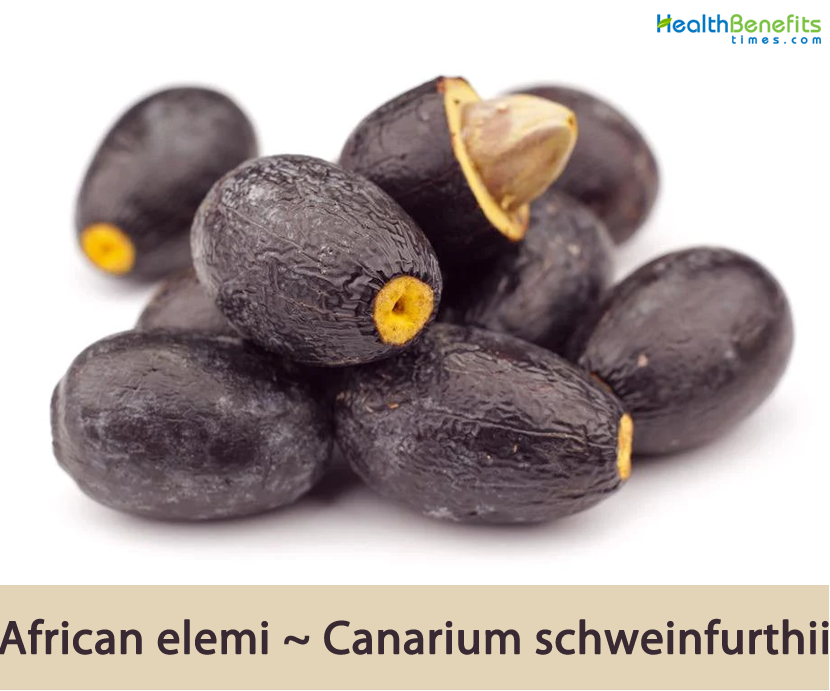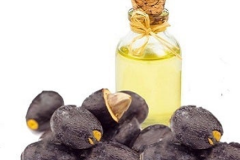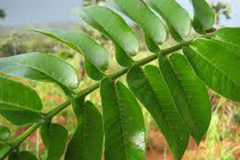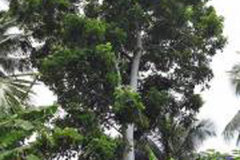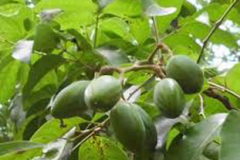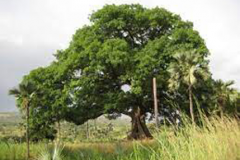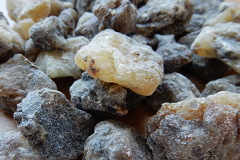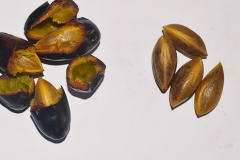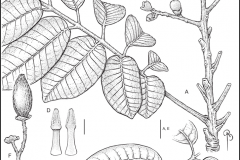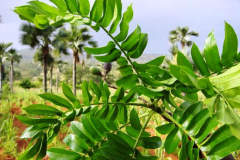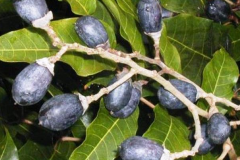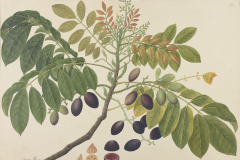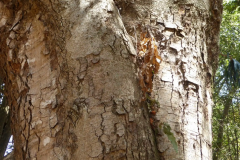| African elemi Quick Facts | |
|---|---|
| Name: | African elemi |
| Scientific Name: | Canarium schweinfurthii |
| Origin | Angola, Mali, Cameroon, The Democratic Republic of the Congo, Ghana, Guinea, Côte d'Ivoire, Ethiopia, Nigeria, Guinea-Bissau, Senegal, Sierra Leone, Tanzania, Uganda, United Republic of Togo, Central African Republic, South Sudan, Zambia |
| Colors | Bluish-purple |
| Shapes | Small drupe, glabrous, 3-4 cm long and 1-2 cm thick |
| Health benefits | Beneficial for hypertension, dysentery, gonorrhea, coughs, chest pains, pulmonary affections, stomach complaints, food poisoning, anemia, eyes diseases, helminthes infection, goiter, toothache & cardiovascular health |
| Name | African elemi |
|---|---|
| Scientific Name | Canarium schweinfurtii |
| Native | Tropical Africa including Angola, Mali, Cameroon, The Democratic Republic of the Congo, Ghana, Guinea, Côte d’Ivoire, Ethiopia, Nigeria, Guinea-Bissau, Senegal, Sierra Leone, Tanzania, Uganda, United Republic of Togo, Central African Republic, South Sudan, Zambia |
| Common Names | African Elemi, Bush candle tree, Schweinfurth’s olive, canarium, mupafu, ube osa, mpafu, kenari or mbani |
| Name in Other Languages | Chinese: Fei zhou gan lan Danish: Afrikansk canarium, Afrikansk elemi Dutch: Afrikaanse elemi English: African elemi, Bush candle tree, Schweinfurth’s olive Finnish: Afrikanelemi French: Canari d’Afrique, Élémi d’Afrique Fulah: Mbelametta German: Afrikanische-Elemibaum, Afrikanische-Kanaribaum Greek: Élémi Italian: Canario africano, Elemi africana Malay: Mubafo, Mupaxi Luba Katanga: Mpafu Portuguese: Elemi africana Spanish: Alemí africana Swahili: Mbafu, Mpafu, Kasuku Swedish: Afrikansk canarium |
| Plant Growth Habit | A large forest tree |
| Growing Climates | Riverine forest, forest patches, rain forest, gallery forest, transitional forest |
| Plant Size | 40 m high, but attaining 50 m or more |
| Bole | Bole is straight and cylindrical attaining 20 m long, usually less, by 4.50 m in girth |
| Bark | Bark thick, on young tree fairly smooth, becoming increasingly scaly and fissured with age |
| Leaf | Pinnate, clustered at the end of the branches, and may be 15- 65 cm long, with 8-12 pairs of leaflets, mostly opposite, oblong, cordate at base. Leaflets are 5-20 cm long and 3-6 cm broad, with 12-24 main lateral nerves on each side of the mid-rib |
| Flower | Creamy white unisexual flowers about 1 cm long grow in inflorescences that stand in the axils of the leaves and may be up to 28 cm long. The plant produced flowers during the dry season when the tree is leafless. |
| Fruit Shape & Size | Small drupe, glabrous, 3-4 cm long and 1-2 cm thick. The calyx is persistent and remains attached to the fruit |
| Fruit Color | Bluish-purple |
| Seed | Hard, five-sided, 2 cm long and 1 cm wide, kernel edible and often eaten. |
| Plant Parts Used | Root, bark, fruit, seed, leaf, flower, gum and resin |
| Health Benefits |
|
Plant Description
African elemi is a large forest tree that normally grows about 40 m tall, but it can also attain 50 m or more in favorable conditions. The bole is straight and cylindrical attaining 20 m long or usually less, by 4.50 m in girth yielding a high volume of timber. The bark is thick. On young trees it is fairly smooth and is split off in Gabon to make cylindrical boxes. With age it becomes increasingly scaly and fissured. The sap-wood is whitish to about 10 cm thick. Heart-wood is light brown to pinkish, darkening on exposure to a light brown mahogany color. It is coarse, softish, even woolly, and is scented. Sawing may be difficult owing to the presence of silica, and it tends to blunt tools, but otherwise it can be worked well. It is used locally for furniture, cabinetry, mortars, planks, canoes and more or less general construction work. The tree grows well in riverine forest, forest patches, rain forest, gallery forest as well as transitional forest.
Leaves
Leaves are pinnate, clustered at the end of the branches, and may be 15- 65 cm long, with 8-12 pairs of leaflets, mostly opposite, oblong, cordate at base. Leaflets are 5-20 cm long and 3-6 cm broad, with 12-24 main lateral nerves on each side of the mid-rib, prominent and pubescent beneath. The lower leaflets are bigger than the upper ones. The lower part of the petiole is winged on the upper side.
Flower
The creamy white unisexual flowers about 1 cm long grow in inflorescences that stand in the axils of the leaves and may be up to 28 cm long. The plant produced flowers during the dry season when the tree is leafless.
Fruit
Fertile flowers are followed by small drupe, bluish-purple, glabrous, 3-4 cm long and 1-2 cm thick. The calyx is persistent and remains attached to the fruit. Thin dark bluish skin surrounds a 3 mm layer of flesh that is the edible portion of the fruit. The fruit contains a hard spindle-shaped, trigonous stone that eventually splits releasing 3 seeds. Fruit is similar in size to an olive but is oiler than the African pear. It has a rich, creamy pulp like the avocado. The fruit known as ube okpoko by the Igbos and atili by the Hausas is similar to ube (African pear) yet so different.
Health benefits of African elemi
Listed below are some of the popular health benefits of consuming African Elemi
1. Treatment of Intestinal Worms
Resins collected from the elemi tree can be used for preparing herbal medicines that treat as well as fight against intestinal worms such as roundworm.
2. Treatment of Gastrointestinal diseases
Elemi bark is purgative in nature and it can be decocted and used for treating gastrointestinal diseases such as food poisoning, constipation, stomach upset, ulcer and dysentery.
3. Dermatological Care
The resins serve as emollient, which is effective for treating skin infections such as eczema, skin rashes, and prickly heat.
4. Treatment of Cough
The leaves can be squeezed and used alone or combined with other herbs for treating coughs and cold.
5. Wound Dressing
Elemi resin serves as an alternative for mastic used for dressing wounds.
6. Treatment of Leprosy
African elemi bark can be crushed and used for treating and preventing leprosy attack.
7. Protection against Adenitis
Elemi root offers protection against adenitis, which is a disease condition caused as a result of the inflammation of a gland.
8. Treatment of Wounds
African elemi seeds can be roasted and crushed into powder form, which is mixed with ointments for treating wounds.
Traditional uses and benefits of African Elemi
- In the past, the resin was exported to Europe for pharmaceutical use.
- It was used as a substitute for gum-mastic in making wound dressings in World War II.
- The resin is used against roundworm infections and other intestinal parasites.
- It is an emollient, stimulant, diuretic and has action on skin-affections and eczema.
- The bark is emetic and purgative.
- Decoction of the plant is used as a treatment against hypertension, dysentery, gonorrhea, coughs, chest pains, pulmonary affections, stomach complaints, food poisoning etc.
- The pounded bark is used against leprosy and ulcers.
- Root is used against adenitis whereas root scrapings are made into a poultice.
- Leaves are boiled with other herbs and the decoction is used to treat coughs.
- Seeds are roasted and pounded and the resulting powder is mixed with skin oil or jelly to treat wounds.
- Its decoction is used to cure anemia, eyes diseases, helminthes infection, diarrhea, goiter, gastro-intestinal disorder, toothache, cardiovascular health, yellow fever or to ward off evil spirits.
- Leaves are used as stimulant against fever, malaria, constipation, diarrhea, post-partum pain, rheumatism and sexual transmitted
- Whole plant decoction is a treatment against insects, dysentery, gonorrhea, coughs, chest pains, pulmonary affections, stomach complaints, food poisoning, purgative and emetic, emollient, stimulant, diuretic, skin-affections, eczema, leprosy, ulcers.
- Stem bark decoction is used as a remedy for roundworms, colic, stomach pains, pain after child birth, gale, dysentery and
- In Cameroon, this plant’s resin is burned and its smoke is supposed to ward off evil spirits.
- Decoction prepared with a mixture of leaf and stem bark is taken as a treatment against anemia, diarrhea, helminthes, toothache, rheumatism, roundworms, fever, malaria, pulmonary diseases, gastro-intestinal disorder and sexually transmitted
- Bark-decoction is widely used for dysentery.
- In Sierra Leone a bark-decoction is drunk for coughs and chest-pains, and
- In Congo the sap is eaten with cassava for pulmonary affections where a decoction is also taken in draught for stomach-complaints, food-poisoning, gynecological conditions requiring purging and emesis.
- In Cameroons the bark is used for chancre.
- Fresh bark is administered as an enema in Ivory Coast for intestinal pains and hemorrhoids and jaundice, and is sometimes given to pregnant women as a tonic.
- In Congo it is put into steam-baths for rheumatism.
- The root is used in Ubangi for treating adenitis: the root scrapings are made into a poultice.
Different Uses
- Fuel: The elemi makes a good fuel wood, igniting readily and burning with a lot of heat. The resin burns readily and is used as a bush candle.
- Timber: The sapwood, often very thick up to 15 cm is white with pinkish reflections. The heartwood is pinkish when fleshly cut but darkens to light brown mahogany color. The wood, slightly coarse in texture, has interlocked grains, thus causing a fine striped figure on quarter-sawn boards. Used as a substitute for true mahogany, it seasons slowly but fairly well, works easily, stains and polishes well. End splitting may occur during the drying process. The wood is attacked by termites and fungi. Impregnation of the heartwood is difficult.
- The timber is used as core veneer, for decorative paneling, parquetry, furniture, flooring and for general utility purposes. Locally, the wood is used for mortars, planks, and canoes.
- Gum or resin: The bark exudes a heavy, sticky oleoresin that smells like turpentine and solidifies to a whitish resin. It is obtained by slashing the bark and allowing the colorless expiation to trickle to the ground where it solidifies into a sulphur-yellow opaque resin. The resin is used as primitive illuminant and as incense and releases a lavender-like smell. The flame is very smoky and soot is collected as carbon-black from the outside of pots held over it for use in tattooing and to make ink in Liberia.
- Essential oil: The resin contains 8-20 % of an essential oil, the main constituent of which is limonene. It is rich in phellandrenes, and contains also resins and a bitter principle.
- Poison: The resin is used as a fumigant against mosquitoes.
- Decorative product: The seeds are strung into necklaces or attached to traditional instruments. The bark of young trees is split off in Gabon to make boxes.
- Shade or shelter: The elemi is often left standing on cleared land to provide shade and has potential as a wind break.
- Reclamation: The tree has been planted for reforestation in Uganda.
- Ornamental: The trees’ symmetrical branching makes it an attractive avenue and shade tree.
- Intercropping: The tree does not compete with crops and has potential for intercropping.
Culinary Uses
- The slightly greenish outer pulp of the fruit is oily and edible.
- It can be eaten raw or softened in warm water to improve palatability.
- It tastes similar to olives and is very popular as a snack among herders and children.
- It is often used as a condiment.
- The seed-kernel is oily and edible.
- It is cooked, and is sometimes prepared into a vegetable-butter and eaten as a substitute for shea-butter.
Other Uses
- Bark exudes a heavy, sticky oleoresin that smells like turpentine and solidifies to a whitish resin.
- It is obtained by slashing the bark and allowing the colorless expiation to trickle to the ground where it solidifies into a sulphur-yellow opaque resin.
- Resin is used as primitive illuminant and as incense and releases a lavender-like smell.
- The resin burns readily is used as a bush candle.
- Flame is very smoky and soot is collected as carbon-black from the outside of pots held over it for use in tattooing and to make ink in Liberia.
- Resin is used to repair broken pottery, for caulking boats and as a gum for fastening arrowheads to shafts.
- Resin is used as a fumigant against mosquitoes.
- Elemi is often left standing on cleared land to provide shade and has potential as a wind break.
- It has been planted for reforestation in Uganda.
- The endocarp is used by children as spinning tops.
- Seeds are strung into necklaces or attached to traditional instruments.
- Bark of young trees is split off in Gabon to make boxes.
- Wood is said to secrete oil and is used for canoe making.
- It is used as a substitute for true mahogany.
- Seeds can be used for ornamental purposes such as making necklaces, bangles and costumes.
- Seeds can also be used for making local instruments.
References:
https://www.itis.gov/servlet/SingleRpt/SingleRpt?search_topic=TSN&search_value=506415#null
https://pfaf.org/user/Plant.aspx?LatinName=Canarium+schweinfurtii
http://www.theplantlist.org/tpl1.1/record/kew-2696074
https://en.wikipedia.org/wiki/Canarium_schweinfurthii
https://plants.usda.gov/home/plantProfile?symbol=CASC28


